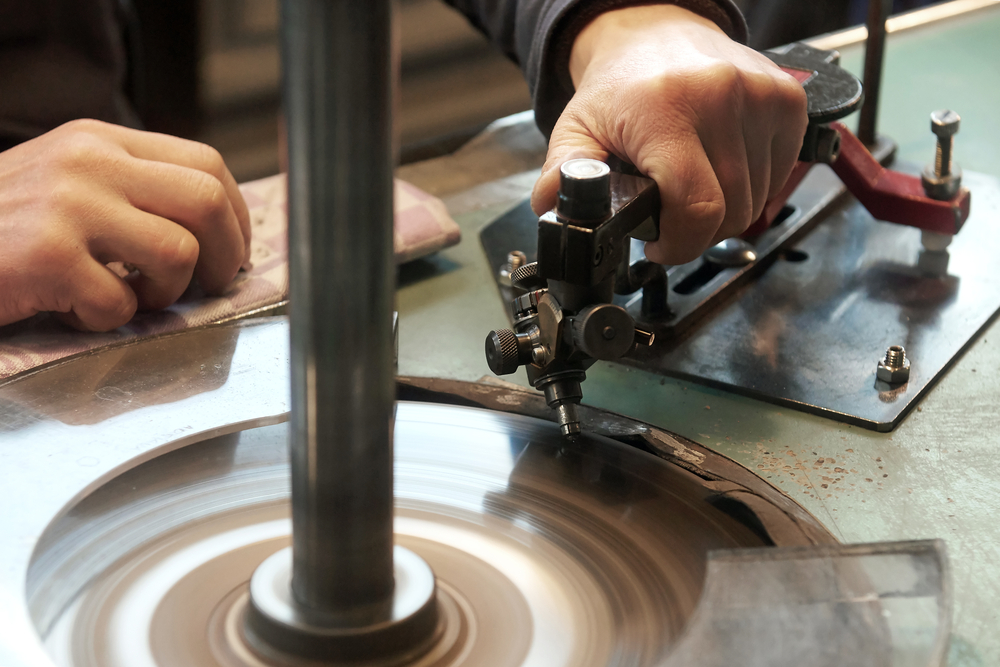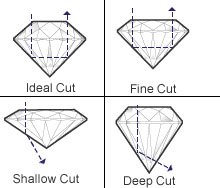Cut

Cut Explained
Cut of a diamond is most commonly defined as the shape a diamond takes, however, there is more to it. Cut is a diamond's most important characteristic. A diamond’s beauty is defined by the precision of its cut. It determines what we generally think of as sparkle. It is recommended that one should select the highest cut grade within your budget. A polished diamond's beauty lies in its complex relationship with light, mainly around:
- how light strikes the surface
- how much of light enters the diamond
- how light returns to the eye
- in what form light returns to the eye
The result of the complex relationship with light is a magnificent display of three attributes. (Describe with images)
Brightness is the combination of all white light reflecting from the surface and interior of a diamond.
Fire describes the "flares" or color emitted from a diamond. It’s the prismatic effect.
Scintillation describes the flashes of light you see, when the diamond, the light source or when the observer moves.
As shown in the images below, when a diamond is well-cut, light enters through the table and travels to the pavilion where it reflects from one side to the other before reflecting back out of the diamond through the table and to the observer's eye. This light is the brilliance we mentioned, and it's this flashing, fiery effect that makes diamonds so mesmerizing.

Diamonds cut exceptionally well to a fairly good proportions will allow maximum amount of light to be refracted from light to the observer. This will give out more brilliance and fire from the diamond.
A diamond with a profound marquee will appear dark in the center of the diamond due to leaking light from the marquee. Diamonds with a fair to poor grading will appear to be like this. Let’s look at the different cuts in a diamond.
Which Grade of Cut Should I Buy?
Selecting the grade of cut is really a matter of preference. To make the best selection, you need to understand the various grades. Please note that the descriptions below are general guidelines.
Ideal Cut: This cut is intended to maximize brilliance, and the typically smaller table sizes of these diamonds have the added benefit of creating a huge dispersion or 'fire'. Ideal quality diamonds are truly for the person who enjoys knowing that he/she has one of the finest things that money can buy. This category applies only to round diamonds.
Excellent: In the case of round diamonds, many Excellent Cut diamonds have cuts that are the equal to any Ideal Cut diamond, though they often can be purchased at a slightly lower price than AGS Ideal Cuts. They are intended to provide maximum brilliance and fire. Precious is what one would call these. At Diamond merchants, we craft these for those precious moments.
Very Good: These diamonds reflect most of the light that enters them, creating a good brilliance. With these diamonds, the cutters have chosen to stray slightly from the preferred diamond proportions in order to create a larger diamond. The result is that these diamonds fall slightly outside of some customers' preferences in terms of, for example, table size or girdle width, though, in many cases many of the parameters of diamonds in this range will overlap with certain parameters of diamonds in the Ideal or Premium ranges. The price ranges of these diamonds are slightly below that of Premium cuts.
Good: Diamonds that reflect much of the light that enters them are good diamonds. Their proportions fall outside of the preferred range because the craftsmen has chosen to create the largest possible diamond from the original rough crystal, rather than cutting extra weight off to create a smaller Premium quality diamond. Diamonds in this range offer an excellent cost-savings to customers who want to stay in a budget without sacrificing quality or beauty.
Fair & Poor: A diamond graded as fair or poor reflects only a small proportion of the light that enters it and the refracted light leaks out. Typically these diamonds have been cut to maximize the carat weight over most other considerations.


